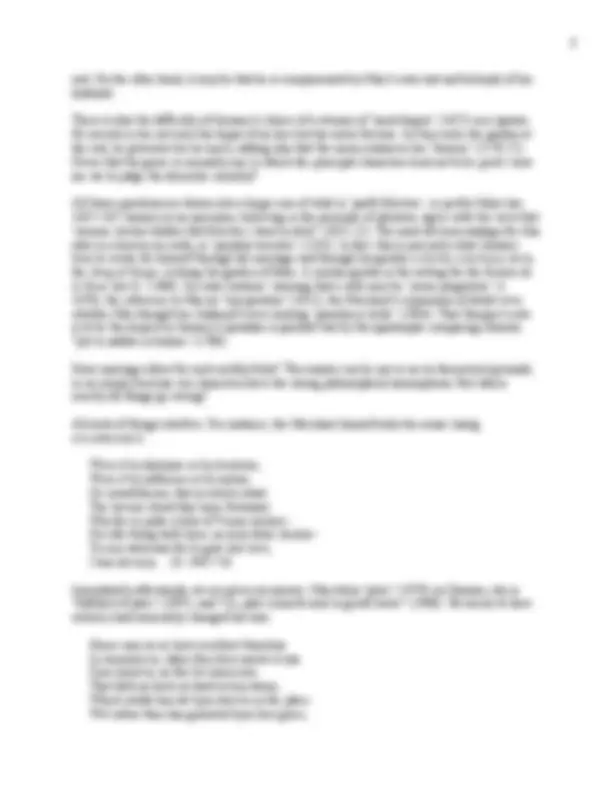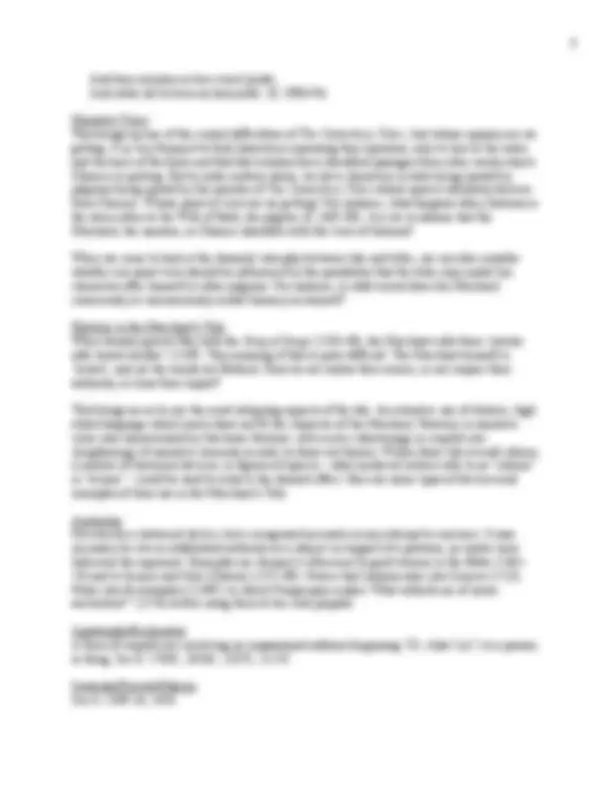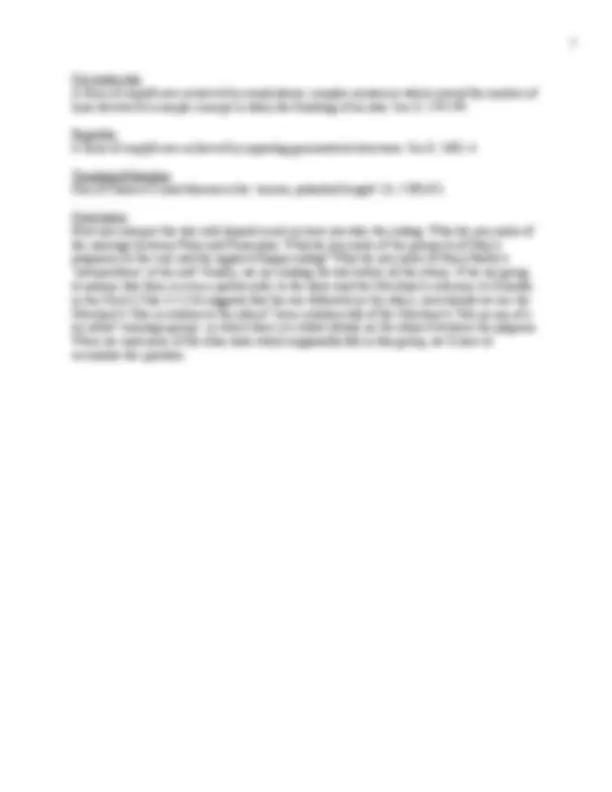





Study with the several resources on Docsity

Earn points by helping other students or get them with a premium plan


Prepare for your exams
Study with the several resources on Docsity

Earn points to download
Earn points by helping other students or get them with a premium plan
Community
Ask the community for help and clear up your study doubts
Discover the best universities in your country according to Docsity users
Free resources
Download our free guides on studying techniques, anxiety management strategies, and thesis advice from Docsity tutors
An analysis of Chaucer's The Merchant's Tale, a fabliau from his Canterbury Tales collection. the tale's themes of marriage, the cunning of women, and the use of rhetoric. It also explores the influence of St. Jerome's Epistola Adversus Jovinianum and the Roman de la Rose on the tale. The document also touches upon the questionable morality of the characters and the role of January's garden as a hortus conclusus.
Typology: Schemes and Mind Maps
1 / 5

This page cannot be seen from the preview
Don't miss anything!




Genre The central episode resembles the medieval narrative genre known as a fabliau (p. fabliaux). According to your book (p. 7),
A fabliau is a brief comic tale in verse, usually scurrilous and often scatological or obscene. The style is simple, vigorous, and straightforward; the time is the present, and the settings real, familiar places; the characters are ordinary sorts -- tradesmen, peasants, priests, students, restless wives; the plots are realistically motivated tricks and ruses. The fabliaux thus present a lively image of everyday life among the middle and lower classes. Yet that representation only seems real; life did not run that high in actual fourteenth-century towns and villages -- it never does -- and the plots, convincing though they seem, frequently involve incredible degrees of gullibility in the victims and of ingenuity and sexual appetite in the trickster-heroes and -heroines. (The Riverside Chaucer, p. 7.)
Of the Canterbury Tales, The Miller’s Tale, The Reeve’s Tale, the Shipman’s Tale, the Summoner’s Tale, and the Cook’s Tale are all fabliaux. The Merchant’s Tale resembles the genre but surprisingly narrated through considerable use of rhetoric. Fabliaux were common in thirteenth-century French literature, and begun to spread into Holland and Germany, but examples are rare in English. Nearly all of them are in The Canterbury Tales. By the time Chaucer turned to the genre most comic tales in other languages were being told in prose. Hence his choice to write poetic fabliaux was something of a throw-back.
The cuckoldings, beatings, and elaborate practical jokes that are the main concern of the fabliaux are distributed in accord with a code of "fabliau justice," which does not always coincide with conventional morality: greed, hypocrisy, and pride are invariably punished, but so too are old age, mere slow-wittedness, and, most frequently, the presumption of a husband, especially an old one, who attempts to guard his wife's chastity. The heroes and heroines, invariably witty and usually young, are those whom society ordinarily scorns -- dispossessed intellectuals (lecherous priests, wayward monks, penniless students), clever peasants, and enthusiastically unchaste wives. Their victims are usually those whom society respects --prosperous merchants, hard-working tradesmen, women foolish enough to try to remain chaste. The fabliau, in short, is delightfully subversive -- a light-hearted thumbing of the nose at the dictates of religion, the solid virtues of the citizenry, and the idealistic pretensions of the aristocracy and its courtly literature, which the fabliaux frequently parody, though just as frequently they parody lower-class attempts to adopt courtly behavior. (The Riverside Chaucer, p. 8.)
This raises the question of who wrote fabliaux and for which audience. Critical opinion has gone back and forth on this issue. We know that some fabliau-writers were certainly aristocrats who presumably wrote for their peers, but since most fabliaux are anonymous, we cannot know the true extent of their appeal. Chaucer, of course, co-ops the genre to his own purposes and his own audience, however much it may be equally difficult to pin down.
Sources Chaucer does not base his plot on any known fabliau. Even if we don’t know a precise source, we are aware of some distant analogues. The ‘Pear Tree’ story was widely known in the Middle Ages in numerous forms. In general, their theme is the cunning of women and their ability to deceive their husbands. Two such tales by one of the most famous medieval writers, Marie de France, date to the twelfth century. There is also a thirteenth-century fabliau by a writer known as Guèrin called ‘The Priest who Peeked’. By the fifteenth century, a fable about a blind man and a pear tree was commonly attributed to “Aesop”.
Thematically, the Merchant’s Tale draws most of all on St Jerome’s (c. 347-420) Epistola Adversus Jovinianum, or Epistle against Jovinian (AD 393). It was written to refute the contention of a monk named Jovinian that “a virgin is no better as such than a wife in the sight of God.” Jerome argued that virginity was a higher moral state. This text incorporated a smaller text called the Liber aureolus de nuptiis, or the Golden Book of Marriage, attributed to the Greek philosopher Theophrastus (d. 287 B.C.). This is the Theofraste cited by January in the Merchant’s Tale. The Merchant’s account of his own marriage also resembles aspects of the discussion of marriage in the Roman de la Rose. There are also numerous citations from the Bible, notable the Song of Songs, an erotic work which courtly poetry drew on, and which moralists had to allegorise in order to make it acceptable.
Interestingly, the Merchant’s Tale often seems to draw on other of the Canterbury Tales. Justinus cites the Prologue of the Wife of Bath (VI.1685), and January's idea of a good wife seems to be based on the Clerk's Tale (cf. IV.2345-46 and IV. 351-57). Some of the ideas set forth in the debate on marriage echo those in the Parson's Tale (see n. 1441-55, p. 886 in The Riverside Chaucer) and the good wives cited are those listed in the The Tale of Melibee (VII. 2551-74).
Themes Clearly, marriage and its value are an important theme in the tale. Harry Bailly recognises as much, when he notes that it is a tale of wicked wives in the epilogue, and that seems to be the Merchant’s intention. The citation of Theophrastus/Jerome, which presents arguments against marriage (though for a specific purpose) reveals as much. Furthermore, the tale abounds in imagery associating marriage with binding (1226-27, 1261-62, 1281-85, 1391-92, 1837, 2432). Especially important is the ironic encomium in ll. 1281-85, which links the tale to the prologue. The encomium adds little to the plot but a lot to the narrative voice.
The problem is that the tale is not merely a narrative exemplum of yet another wicked and deceptive wife. January’s physical repulsiveness and grotesque love-making certainly do not create a lot of sympathy for him (ll. 1819-65). He is a senex amans, an inappropriate old man in love (or dirty old man), whose lust for a younger woman is no more than self-indulgence. His arguments in favour of marriage to a younger woman, and in favour of the virtues of marriage in general tend to encourage this view. To the medieval audience, it was entirely natural and inevitable for him to be cuckolded, though it is unclear how much sympathy they would have for the cuckolding wife.
The matter is complicated by large issues. First of all there is the domestic treachery. The otherwise sympathetic squire Damian who January thinks is so gentil is anything but so in the
And hem rejoysen in hire crueel pryde, And rekke nat to been an homycide. (ll. 1986-94)
Narrative Voice This brings up one of the central difficulties of The Canterbury Tales. Just whose opinion are we getting. It is very frequent to find characters expressing their opinions, only to turn to the notes and the back of the book and find that scholars have identified passages from other works which Chaucer is quoting. But to make matters worse, we have characters in tales being quoted by pilgrims being quoted by the narrator of The Canterbury Tales whose speech ultimately derives from Chaucer. Whose point of view are we getting? For instance, what happens when Justinus in the story refers to the Wife of Bath, the pilgrim (ll. 1685-88). Are we to assume that the Merchant, the narrator, or Chaucer identifies with the view of Justinus?
When we come to look at the dramatic interplay between tale and teller, we can also consider whether our point view should be influenced by the possibility that the teller may model his characters after himself or other pilgrims. For instance, to what extent does the Merchant consciously or unconsciously model January on himself?
Rhetoric in the Merchant’s Tale When January greets May with the Song of Songs (2183-48), the Merchant calls them ‘swiche olde lewed wordes’ (2149). This meaning of this is quite difficult. The Merchant himself is ‘lewed’, and yet the words are Biblical. Does he not realise their source, or not respect their authority, or miss their import?
This brings us on to one the most intriguing aspects of the tale: its extensive use of rhetoric, high styled language which surely does not fit the character of the Merchant. Rhetoric in narrative verse was characterised by two basic features: abbreviatio (shortening) or amplificatio (lengthening) of narrative elements in order to draw out themes. Within these two overall rubrics, a number of rhetorical devices, or figures of speech – what medieval writers refer to as ‘colours’ or ‘termes’ – could be used to achieve the desired effect. Here are some types of devices and examples of their use in the Merchant’s Tale.
Auctoritee Not strictly a rhetorical device, but a recognised necessity in any attempt to convince. It was necessary to cite an established authority on a subject in support of a position, no matter how ludicrous the argument. Examples are January’s references to good women in the Bible (1362-
Apostrophe/Exclamatio A form of amplificatio involving an impassioned address (beginning ‘O!, Alas! Lo!’) to a person or thing. See ll. 1783f., 2056f., 2107f., 2125f.
Sententia/Proverb/Maxim See ll. 2109-10, 2410.
Circumlocutio A form of amplificatio achieved by round-about, complex sentences which extend the number of lines devoted to a simple concept or delay the finishing of an idea. See ll. 1795-99.
Repetitio A form of amplificatio achieved by repeating grammatical structures. See ll. 1601-4.
Translatio/Metaphor One of Chaucer’s most famous is the ‘mirour, polisshed bryght’ (ll. 1580-87).
Conclusion How you interpret the tale will depend much on how you take the ending. What do you make of the marriage between Pluto and Proserpina. What do you make of the prospects of May’s pregnancy at the end, and the apparent happy ending? What do you make of Harry Bailly’s ‘interpretation’ at the end? Finally, we are reading the tale before all the others. If we are going to assume that there is even a partial order to the tales (and the Merchant’s reference to Griselda in the Clerk’s Tale (l 1224) suggests that the one followed on the other), how should we see the Merchant’s Tale in relation to the others? Some scholars talk of the Merchant’s Tale as one of a so-called ‘marriage-group’, in which there is a whole debate on the subject between the pilgrims. When we read some of the other tales which supposedly fall in this group, we’ll have to reconsider the question.